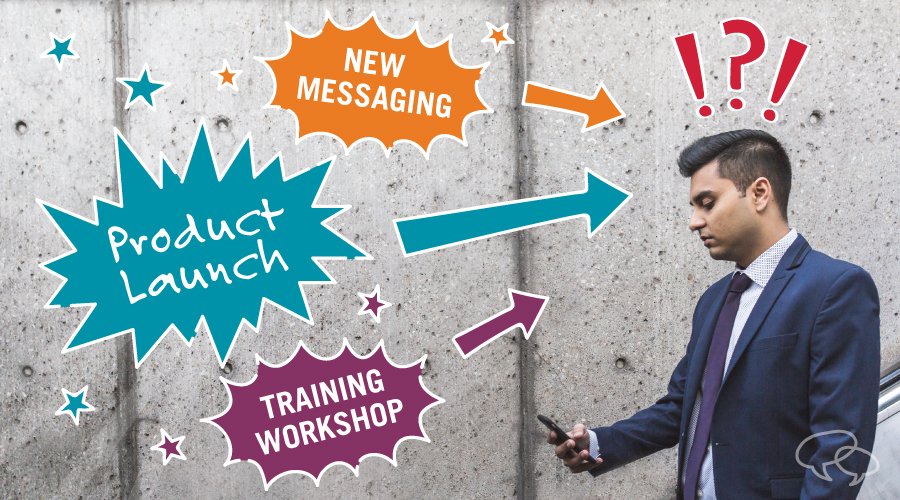It’s Time for Just-in-Time, Situation-Specific Enablement
There’s all kinds of tools and apps promising to help your salespeople “in the moment”—across the different types of selling situations they face.
However, the marketing messaging, content assets and skills training needed to take advantage of these “situational sales enablement” technologies have not been ready, leading to many technology failures due to lack of adoption.
However, that is changing…and fast. Here’s a quick look at three trends happening right now that are making it possible to provide just-in-time, situational messaging, content assets and skills training to enable salespeople to have the right conversations at each stage of the customer lifecycle.
- Situational Messaging Frameworks – one-size-fits-all messaging is being replaced with tested, proven frameworks for creating messages that work for different moments of truth in the customer lifecycle.
- Situational Skills Training – stand-alone skills training over the course of days in classrooms is being replaced by short, compelling video-based skills coaching modules that are aligned to the various selling scenarios.
- Integrated, Interactive Online Experiences – static playbooks are being replaced with interactive, mobile experiences that combine your stories and your skills in one situational messaging and coaching experience
It’s the convergence of stories (marketing messaging and content assets) with skills in a singular virtual experience for the salesperson. Imagine giving reps specific messaging and skills coaching for the exact selling situation they find themselves in — whenever and wherever they need it.
This changes the game significantly for product launches and training plans. You should no longer stand for stand-alone product messaging rollouts or isolated, skills-only training events.
That’s because your go-to-market strategies are not created equal, which means your messaging and skills need to be situational.
For example:
- Some are for highly disruptive products or services that require you to challenge the status quo and create a need for change. This requires a messaging approach and distinct selling skills designed to defeat status quo bias and introduce the necessary urgency to change. For this scenario, you need to identify the unconsidered needs your prospects haven’t considered, and then map those needs to your unique capabilities, creating a buying a vision that gets prospects to see the value of doing something different than what they’re doing today.
- Contrast this to a scenario where you are launching an upgrade to an existing product in a mature market where you are hoping to provide some differentiation that helps you take some share and protect your pricing premium. This requires a messaging approach and selling skills that de-commoditize the conversation and allow you to hold the line on discounts.
- Or maybe, you are combining several products and services into a solution or key, topical initiative, hoping to elevate your sales conversations to more senior-level buyers? This requires yet another messaging model and a separate set of skills for salespeople to provide a business case that passes muster with executive and financial decision makers. Specifically, you’ll need to be effective at adopting an executive buyer’s perspective, conducting CXO-relevant industry or company research, showing the value proposition of a business change scenario, and demonstrating your business impact.
In any of these cases, what good is it if you launch a bunch of messaging to the field and your salespeople don’t have the pre-requisite skills to execute the story — because your skills training program is on a completely separate track and timing?
Or the other way around…what good is it if your skills training courses teach your salespeople how to engage in each of these selling scenarios, but your messaging and content assets don’t align with or reinforce those skills?
The barriers to accomplishing this convergence of stories and skills have been eliminated, and the following factors are playing a major part in that:
- Tested and proven messaging frameworks are now available for each key moment in the customer lifecycle – Why Change? Why You? Why Now? Why Pay? Why Stay? — ensuring your messaging is developed for maximum impact in each situation.
- Skills training competencies are being chunked up and virtualized in short- and long-form eLearning content that matches each of those key moments in the customer lifecycle, and they can be attached to the messaging for situationally-relevant coaching on how to deliver the story as intended, using the same science to tell the story as you used to create the story.
- All of this is being served up in an integrated, interactive format that can be accessed from anytime, anywhere by salespeople, including on their mobile devices without another piece of software or technology.
The days of stand-alone product launches, messaging rollouts or sales skills training are over, making way for just-in-time, situation-specific learning and execution.
Want more on this topic? Check out our eBook: Enabling the Just-in-Time, Situational Learner.
This article originally published in CMO.com.






